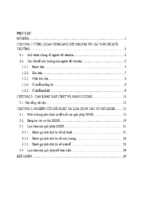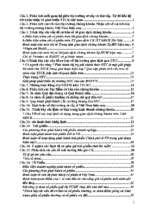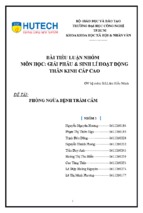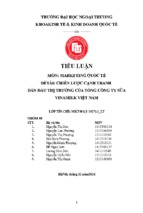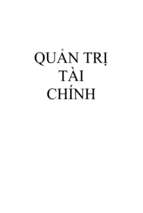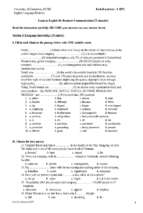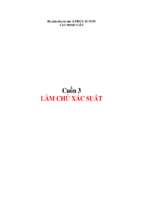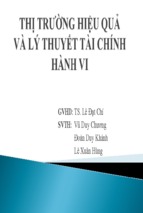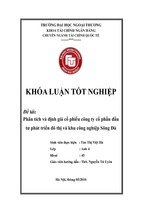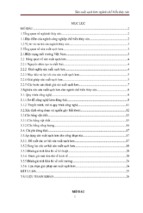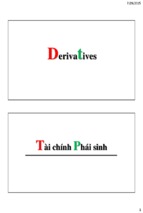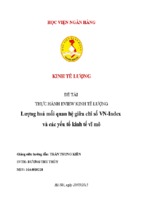The study focuses on the characteristics of Board of Directors (BOD) and their influences on the enterprise value in the data set, which consists of 100 non-financial enterprises listed on HOSE and HNX with 800 observations from 2008 to 2015. Furthermore, I use system GMM for generalized estimation which allows controlling endogenous problems. The two theories: agency theory and resource dependence theory help explain the research results. The characteristics of BOD include the board diversity, board size, non-executive directors, CEO duality, ownership structures and the qualifications of BOD. The firm performance is measured by Tobin’s Q. The results show that the gender diversification, CEO duality, ownership structure and qualifications have effects on firm performance while other variables do not. This study provides information about the characteristics of corporate governance by showing the empirical evidence for Vietnam market - one of the emerging markets in Asia.
Abstract
The study focuses on the characteristics of Board of Directors (BOD) and their influences on the
enterprise value in the data set, which consists of 100 non-financial enterprises listed on HOSE
and HNX with 800 observations from 2008 to 2015. Furthermore, I use system GMM for
generalized estimation which allows controlling endogenous problems. The two theories: agency
theory and resource dependence theory help explain the research results. The characteristics of
BOD include the board diversity, board size, non-executive directors, CEO duality, ownership
structures and the qualifications of BOD. The firm performance is measured by Tobin’s Q. The
results show that the gender diversification, CEO duality, ownership structure and qualifications
have effects on firm performance while other variables do not. This study provides information
about the characteristics of corporate governance by showing the empirical evidence for Vietnam
market - one of the emerging markets in Asia.
Key words: Board of directors, coporate governance, firm performance, endogeneity, GMM,
panel data, Vietnam.
1. Introduction
In current business environment, competitions have become increasingly competitive, especially
companies in the same industry. Following movement trend of the economy and development
process, many enterprises are now transforming into Joint Stock Company and people who
invest capital in these enterprises (shareholder) establish a Board of Directors (BOD) to represent
them. It is a group of many individuals who have excellent qualifications to implement corporate
management functions. Adam and Ferreira (2009) suggested that the two most important
functions of a BOD are consultancy and monitoring. Consulting function is performed by
executive and non-executive board members, especially the role of non-executive ones for their
business relationships with important outside resources. Moreover, monitoring function will help
to reduce opportunity cost; it depends on the characteristics and performance of BOD. Both
functions play a vital roles in firm performance. They ensure that managers always take action
for the purpose of maximizing the benefit of shareholders. Therefore, we can see the importance
of BOD. In addition, it holds many expectations about maximization of shareholder benefit
because not just does it prevent poor management causing violation in business but also takes
advantage of opportunities to increase enterprise value. According to Vietnam Enterprise Law
(2005), BOD limits violations and influences the monitoring mechanism for managers.
Moreover, it also affects the appointment, dismissal, suspension and compensation policies.
Together with such roles, it is necessary to carry out research “The effect of corporate
governance on firm performance in Vietnam”.
In fact, although there are many researches on the characteristics of board of directors that affect
enterprise value, they have different results. It may be due to different legal, social and economic
conditions in countries as well as different stock markets in the developed countries and
emerging markets.
Stock market in Vietnam was established in 2000 and became increasingly exciting in 2007
when Vietnam integrated in WTO (World Trade Organization). Thus, the stock market in
Vietnam is still young. In fact, many companies listed on Vietnam’s stock market do not
understand well the corporate governance due to lack of theoretical foundation of corporate
governance and the theory of role and characteristics of BOD. Therefore, they have problems
about information, resulting in unreality reflection of enterprise value. From these problems, this
research is very necessary.
Non-financial companies mentioned in this research are obtained on Ho Chi Minh City Stock
Exchange (HOSE) and Hanoi Stock Exchange (HNX) in the period of eight years from 2008. In
this research, I exclude financial and banking firms because (i) their liquidity and management
may be affected by different legal factors, (ii) these firms have particular business environment,
which are shown in the significant difference in financial ratios and legal requirements. Thus, the
research results will be misleading if research sample includes these enterprises (Bauer et al,
2008; Dittmar and Mahrt-Smith, 2007; Mak and Kusnadi, 2005; Schultz et al, 2010). In addition,
100 non-financial enterprises are selected on the ground of available financial statements, annual
reports and the prospectus from 2008 to 2013. Moreover, industry classification in the research
replies on GISC (Global Industry Classification Standard) developed by MorganStanley Capital
and S&P. Therefore, the data includes 800 observations of enterprises by year in which relatively
sufficient information about corporate governance are used.
Regarding contribution, this research is implemented in Vietnam. Furthermore, the length of this
is eight years from 2008, which is large enough to explain the influences of characteristics of the
BOD on enterprise value. In addition to this, the results are very useful for policymakers, listed
companies and investors and encourage researchers to concern about corporate governance in the
stock market in Vietnam.
The research includes five chapters. Chapter 1 is an overview of research which indicates its
contribution. Chapter 2 is the theoretical foundation and overview of previous studies. Next are
the data, research methods, models and variables measurement. Chapter 4 is the empirical
results and the last one is conclusion and limitation.
2. Theories and literature
This section shows the theories related to Board of Directors, which mainly emphasizes the role
of Board of Directors and enterprise value. The layout is presented as follows: (i) role of BOD,
(ii): related theory, (iii): the effect of the coporate governance on enterprise value.
2.1. Role of Board of Directors
According to the International Finance Corporation (IFC), corporate governance is defined as
“the structures and processes by which companies are directed and controlled”. In 2004,
following Organization for Economic Co-operation and Development (OECD), the definition
was “Corporate governance involves a set of relationships between a company’s management, its
Board of Directors, its shareholders and other stakeholders. Corporate governance also provides
the structure through which the objectives of the company are established, and the means of
achieving those objectives and monitoring performance are determined. Good corporate
governance should provide proper incentives for the Board of Directors and management to
pursue objectives that are in the interests of the company and its shareholders, thereby
facilitating the effective use of resources.”
Generally, it includes internal and external governance mechanisms, and the BOD is the former
one representing the relationship between capital providers (shareholders) and capital users
(director/general manager) to create and increase enterprise value (Fama and Jensen, 1983).
Under Enterprise Law in Vietnam (2005), “Board of Directors is a corporate governance which
has full authority to decide, implement the rights and obligations not under the control of the
Annual General Meeting”. The Board of Directors works effectively when it completes its role
successfully. According to Pfeffer and Salancik (1978), BOD has three main roles: (1) the
mechanism for determining approaches to important resources for enterprises; (2) the marginal
factor obstructing the work and (3) increasing legitimacy for the organization. Regarding
Hillman and Dalziel (2003), BOD has two roles: (1) controlling business and (2) providing the
methods approaching resources. According to Babic et al (2011), the role of Board of Directors
includes: (1) controlling; (2) supporting and (3) strategizing. In this research, the role of BOD
will be presented by the approach method of Babic et al (2011) by which the role of Board of
Directors will be associated with the related theories such as agency theory and resource
dependence theory. This connection is considered as the contribution to explanation the effect of
the coporate governance on enterprise value.
Controling role
According to Fama and Jensen (1983), the BOD is an internal governance mechanism that
controls the managers through processes of decision making, approval and monitoring. The
process consists of four steps: (1) initiation; (2) confirmation; (3) implementation and (4)
supervision; the first two steps are to make decision and the others are to monitor decision
making. Therefore, controlling is the fundamental role of BOD. Regarding Zahra and Pearce
(1989), controlling fulfills crucial function of BOD and also relates to the responsibilities of
BOD’s members for appointing someone to be the director manager; monitoring; explaining the
audit report and ratifying the decision. Furthermore, controlling is also illustrated through the
other critical activities such as recruitment, appointment and dismissal of managers; confirmation
objectives or monitoring the effectiveness of management level in order to ensure and increase
the benefits to shareholders (Babic et al, 2011). According Baysinger and Hoskisson (1990),
controlling includes two functions: (1) financial control and (2) strategic control. Financial
control involves in short-term profit maximization and replies on evaluation of managers’
performance, whereas strategic control addresses a company’s long-term existence and
profitability.
However, BOD not only controls activities but also consults and gives a suitable orientation for
managers, which is called supporting role.
Supporting role
According to Pfeffer and Salacik (1978), BOD’s members provide advices and expertise,
resources approaches, and legitimacy. Simultaneously, they also contribute to making strategic
decision by providing accessibility to key resources related to business activities. They select
external influences, thereby offering reasonable approaches related to business activities; realize
relationships between BOD’s members and relevant factors to ensure pivotal company resources.
Additionally, they enhance the company’s reputation, and advise the management during the
strategic decision-making process (Babic et al, 2011). Moreover, they can provide the managers
with advice during strategic decision-making process and help them achieve the business goals
through their knowledge (Carpenter and Westphal, 2001).
Stratergic role
Chandler (1962) defined strategy as the determination of the basic long-term goals and
objectives of an enterprise, and the adoption of courses of action with the allocation of resources
necessary for implementing these goals. Therefore, companies are required to identify their
strengths, and then make the strategic decisions to increase competitiveness. The strategic
decisions will determine the direction of future company’s objectives with many aspects such as
finance, time, product manufacturing. These aspects will determine the success or failure of the
companies, especially in the global integration.
The BOD’s roles may also be explained via two different perspectives - an active one and a
passive one. According to the passive perspective, the BOD has no significant influence on the
company’s strategic development, and its responsibility is merely defined within the evaluation
of the strategy adopted by top management. Otherwise, following a positive one, the BOD exerts
influences on developing business strategy. Therefore, they are required to take more
responsibility in that process as well as decision-making because it will affect the enterprise
value (Babic et al, 2011). According to the OECD (2004), the corporate governance framework
must ensure the strategic orientation. Then, the BOD must be responsible for both the strategy
and contribution to the enterprise.
Table 1: general role of Board of Directors
-
-
Controling role
Maximize of owners’
wealth
Monitoring managers’
activities to ensure that
they are acting for the
interest of owners;
Selecting,
electing
dismissing Board of
Directors;
Approving
major
decisions;
Reducing
agencies’
costs.
-
Supporting role
Representing
a
selection
mechanism
of
affecting
external resource;
Giving advice and supporting
the management;
Company representation;
Ensuring critical resources;
Guiding
managers
to
accomplish
company’s
objectives;
Participating
in
strategy
formulation
and
implementation.
Strategic role
Negative perspective
- No significant influence on
company’s
strategic
development;
- Implementing the strategy of
Board of Directors – the
Board of Directors only
plays role of review and
ratification
Positive perspective
- Board of Directors is an
important
strategic
mechanism in governing the
company;
- Strategic decision-making:
the Board of Directors and
top
management
are
strategic partners in the
strategic
decision-making
process.
Source: Babic et al (2011)
2.2. Theories
This section presents an overview of the agency theory and resource dependence theory. These
theories are considered to be related to the role of the BOD. Moreover, these theories can be used
as a foundation to explain the research findings on the effect of governance structures on
performance for companies.
2.2.1. Agency theory
One of the first studies on agency theory was proposed by Berle and Means (1932). Agency
theory developed by Alchian and Demsetz in 1972; Jensen and Meckling further developed it in
1976. According to this theory, shareholders are the owners or the head of the business. They hire
and authorize to the administrators who are the shareholder representatives. Shareholders expect
representatives will act in their interests. However, the representative may decide to bring their
own interests, not necessarily for the best interests of the shareholders (Eisenhardt, 1989).
Therefore, the employer must supervise representatives and pay monitoring costs. At the same
time, the representatives will accept to bear the expenses of constrain. Total of monitoring costs,
expenses of constrain and loss expenses is called the cost of representation. In addition, a form of
the cost of representation derives from conflicts of interest between shareholders and corporate
executives due to the separation between management and ownership (Davis, Schoorman and
Donaldson, 1997). This cost is called agency cost. When shareholders are restricted or lost
control to the administrator, then the administrator will have motivation to participate in the
beneficial activities for them. Moreover, another form is demonstrated by debt costs, arising from
the conflicts of interests between shareholders and creditors. Shareholders may possess the
property of creditors by increasing investment risk (Jensen and Meckling, 1976) in case
enterprises have loan. In addition, when companies are in financial distress, conflicts of interest
between shareholders and bondholders could make shareholders acting for their own interests to
profit. Losses are incurred by creditors by game theory to reduce the total value of enterprise.
There are many mechanisms to control representative costs. Jensen and Meckling (1976)
recommended the use of financial leverage, design of incentive contracts as share ownership and
stock options to focus the efforts of the administrator on the interests of shareholders. Rozeff
(1982) and Easterbrook (1984) made recommendations that the dividend can be considered as
the tool to reduce representative expense; because with dividend, on the one hand, it provides the
encouragement, on the other hand, it avoids excessive investment and creates external oversight
mechanisms, thereby limiting the abuse of the free cash flow of administrators.
2.2.2. Resource dependence theory
Resource dependence theory is started from the studies in economics and sociology, while
focusing on the association role of member of BOD. The BOD’s members can both operate in
host enterprise, and have positions of management in other ones. These members will act as a
bridge between enterprise and competitors and other stakeholders (Zahra and Pearce, 1989).
According to this theory, the BOD is considered as a voting mechanism in the enterprise to shape
the linkages with the environment outside the enterprise, while receiving the influential and
important resources to make stepping stones for enterprises to handle the adverse changes in the
business environment (Pfeffer, 1972; Pfeffer and Salancik, 1978; Pearce and Zahra, 1991). These
resources are general, unique and are essential for the growth of the enterprise. Specifically, the
resources include all sources of asset formation, operation capital, business processes, business
type and the ability to receive and respond to information as well as the application of the human
knowledge of the enterprise, thereby increasing the enterprise value (Daft, 2008). The keynote of
this theory states that the enterprises make efforts to control business environment by selecting
the necessary resources for survival (Pfeffer and Salancik, 1978). Accordingly, the BOD plays a
role as a bridge between the enterprise and the basic resources; at the same time, enterprise will
receive external resources to operate more efficiently. With the role of resource constraint,
external BOD’s members will provide resources for the enterprise such as receiving and
responding to information, skills and knowledge, accessibility to key components (such as
suppliers, customers, policy makers, social groups) and the legitimacy of business operation
(Hillman et al, 2000).
Pfeffer and Salancik (1978) stated that resource dependence theory replies on the idea that the
environment provides scarce resources. Thus, the organization depends on that limited resources
to survive. To ensure the survival and development of their own, they have to develop methods
for using of resources effectively. In addition, they also said that the role of the Board of
Directors is to link the enterprise with other external organizations to address the dependence on
the environment.
Therefore, as a mechanism for internal management of the enterprise, in order to improve and
enhance enterprise value, the BOD clearly defines and ensures the effectiveness of its role. This
requires that the Board should have specific characteristics. The next section presents the
characteristics of the Board of Directors that affects the value of the enterprise.
2.3. The corporate governmances affect the firm performance
2.3.1. Board diversity
Board diversity is the proportion of female members in total members of BOD. Women
contribute to the diversity of the Board of Directors. In agency theory, the board diversity is more
independent (Jensen and Meckling, 1976). In resource dependence theory, the board diversity
helps to ensure important resources of the secrets of the enterprise and creates the condition for
connection between enterprise and the external environment including the credibility and
legitimacy (Pfeffer et al, 1972).
However, the empirical reseaches have different results. Particularly, Erhardt et al (2003) did
research on 127 large enterprises in the United States during the period of 1993-1998 to consider
the diversity of the Board of Directors (as measured by the proportion of women in the Board)
and financial performance (as measured by ROA). The results presented a positive relationship
between the diversity of the Board of Directors and enterprise value or Dezso and Ross (2012)
used a large observation sample include 21,790 observations of enterprises publishing financial
information on CompuStat of S&P in the period of 1992- 2006. The study results demonstrated
that the presence of women in the Board of Directors innovates the business strategies and
thereby, having positive influence on the enterprise value. By constract, Bohren & Strom (2010)
did a research in non-financial Norwegian listed compamies in the period from 1989 – 2002 and
this result illustrated the negative relationship between gender diversity of BOD and the value of
firms measured in ROA and Tobin’s Q. By similarity, Ahern & Dittmar (2012) showed the
proportion of female in BOD have negatively effect on firm performance measured in Tobin’s Q.
Furthermore, Tuan Nguyen et al (2015) did a research on 257 Singaporean non-financial listed
companies from 2008 – 2011 and showed the gender diversity has a negative effect on firm
performance. More interestingly, Rose (2007) studied on the Copenhagen Stock Exchange in
Denmark from 1998 to 2001, the result presented there is no relationship between gender
diversity and firm performance (as measured in Tobin’s Q). Moreover, Smith et al (2008) used a
sample of 10000 observations in the period from 1994 – 2003 and illustrated the percentage of
female in BOD does not have effect on listed enterprises.
With positive influence of the board diversity on enterprise value which is predicted by agency
theory and resource dependence theory, I propose the following hypotheses:
Hypothesis 1: Board diversity positively affects the value of the listed enterprise in Vietnam
2.3.2. The size of board of directors
Board size is the member of directors in BOD, including executive directors and non-executive
directors. Dalton et al (1999) argued that the size of the BOD is one of the most important
characteristics of its functions. However, there is uneven between agency theory and the resource
dependence theory of the affect of the size of the BOD on enterprise value.
Agency theory predicts a negative effect (Jensen, 1993). This may be due to large-scale BOD
that has advantages in improving the functions of management board such as the consulting
support, autocratic reduction of the administrators. However, the increase of the size of the BOD
to a certain level will be ineffective due to increasing dependence and subjectivity within the
BOD. Additionally, he recommended that the BOD size should not exceed seven people for all
kinds of enterprises as this is the optimal level. While resource dependence theory suggests a
positive effect (Dalton et al., 1999), the greater size of BOD will positively affect the enterprise
value and administrators will receive better advices, better orientation with large-scale BOD.
Regarding to resource dependence theory, the big size of BOD supports and increases in the
value of enterprises in the limited resources (Pfeffer & Salacncik, 1978)
Results of practical researches, Beiner et al (2006) did a research on 275 firms quoted at Swiss
stock market (SWX) in 2002 and demonstrated positive relationship between the sizes of the
BOD with Tobin’s Q whereas Yermack (1996) used Tobin’s Q index to measure enterprise value,
with the number of observations was 452 enterprises of major industries in the U.S. over the
period of 1984-1991. The results portrayed that board size negatively affect Tobin’s Q index.
Similarity, Tuan Nguyen et al (2015) presented the negative relationship betwwen board size and
firm performance measured in Tobin’s Q. However, research by Beiner et al (2004) with the data
of 165 companies listed on the Swiss stock market demonstrated no positive relationship
between the sizes of the BOD with Tobin’s Q or Schultz et al. (2010), Wintoki et al. (2012)
concluded that this influence was not statistically significant after controlling for endogenous
problems.
Due to the conflict between agency theory and resource dependence theory of the effect of the
size of BOD on enterprise value, I propose the second hypothesis is as follows:
Hypothesis 2: Board size affects the value of the listed enterprises in Vietnam
2.3.3. The non-executive of board of directors
According to Clifford and Evansm (1997), non-executive directors are the ones that not
implement the execution. Non-executive directors are not the Director (General Director),
Deputy Director (Deputy General Director), Chief accountant and other administrative officers
appointed to the Board (Item 2, Article 2 of Circular 121/2012 - Vietnam).
Agency theory suggests a higher proportion of non-executive directors will bring higher better
supervision (Fama and Jensen, 1983; Jensen and Meckling, 1976). It is assumed that the nonexecutive directors can perform their supervision functions better than the executives when they
are less dependent on business management (Fama and Jensen, 1983). Nicholson and Kiel
(2007) argued that if the supervision function of the BOD is effective, the interests of
shareholders will be then increased because of the minimized cost of representation. This
conception is considered appropriately for the conception of resource dependence theory.
In emperical researches, Hermalin and Weisbach (1998), when they conducted a study of 142
companies listed on the U.S Stock Exchanges during the period of 1971-1983, it portrayed that
the number of non-executive directors tended to increase when the enterprises are in a difficult
situation, because they expect these members will improve enterprise value over that period.
Besides, Bhagat and Bolton, 2008 used the sample on CompuStat of S&P, IRRC and TCL, GIM,
BCF indices in the period from 1990 to 2004 and indicated the negative relationship between the
non-executive directors of BOD and firm performance measure in ROA. By constract, Tuan
Nguyen et al (2015) presented there is no relationship between non-executive directors in BOD
and firm performance.
With the positive effect of the ratio of non-executive directors on the enterprise value predicted
by agency theory and resource dependence theory, I propose the following hypothesis:
Hypothesis 3: The proportion of non-executive directors has positive influence on the value of
the listed enterprises in Vietnam.
2.3.4. CEO duality
CEO duality happens when Chairman of Board also takes the position of management in an
enterprise (director/general director). On the ground of agency theory, CEO duality cause the
difficulties for Board (Donaldson and Davis, 1991) due to supervision and administration
functions tends to be abused for personal benefits and representation costs tend to rise higher.
The focus over the management and control of an individual’s decision will negatively affect
enterprise value and reduce the role of the Board in the supervision to the managers (Fama and
Jensen, 1983).
Practical research on the influence between CEO duality and enterprise value has conflicting
results. Gill and Mathur (2011) conducted the study of 91 listing listed manufacturing companies
on the Toronto Stock Exchange of Canada during period of 2008-2010 and discovered the
positive relationship between the CEO duality and enterprise value of manufacturing industry
while Daily and Dalton (1994) studied the stage of enterprises at their year 5 th and year 3rd before
they went bankrupt in 1990, they discovered that the enterprise that not separate CEO duality
have high possibility of bankruptcy or Haniffa, R & Hudaib, M., (2006) did research 347
Malaysian listed enterprises from 1996 and 2000 and showed the negative relationship between
CEO duality and firm performance. Interestingly, Chen et al (2008) used the sample in
Compustat method from 1993 – 2003 and showed there is no effect between CEO duality and
firm value or Tuan Nguyen et al presented the CEO duality does not affect the firm performance.
On the ground of agency theory and documents on the influence of the CEO duality on the
enterprise value, I propose the fourth hypothesis as follows:
Hypothesis 4: CEO duality has the negative influence on the value of the listed enterprises in
Vietnam.
2.3.5. The ownership of the board of directors
Agency theory illustrates that the percentage of ownership of the BOD’s members is one of the
important mechanisms to monitor the behavior of management. One of the authors that have
quite early research on this relationship is Berle and Means (1932). The authors stated that the
percentage of equity ownership really affects corporate profitability. Therefore, it is needful to
separate ownership and control right when the company is transformed into the joint stock
company. Such separation between ownership and control will increase the professionalism and
expertise in enterprise through expert management skills and professional of business. However,
because of the separation between ownership and control rights generating the costs of
shareholder representative and administrators, shareholders should establish the BOD, which
performs monitoring functions to reduce agency costs (Fama and Jensen, 1983). Moreover, in
order to operate effectively, it is necessary to stick to the benefits of shareholders and the BOD
through capital ownership ratio (Jensen and Meckling, 1976). The percentage of ownership of
the BOD help shareholders mitigate problems arising from the separation between ownership
and control rights; thereby increasing enterprise value.
However, the practical evidences on the effects of equity ownership percentage of board
members on the enterprise value were unclear and inconsistent between different markets. Tuan
Nguyen et al (2015) illustrated the possitive relationship between ownership of BOD’s members
and Singaporean firm performance listed companies. By constract, Farooque et al (2007) studied
on the companies listed in the Dhaka stock exchanges (Bangladesh) in the period of 1995-2001
with 660 observations. The authors used OLS method and discovered the opposite effect of the
percentage of ownership of the Board on the enterprise value (measured by Tobin’s Q) or Hu et
al (2010) did research on 304 publicly listed companies from 2003 to 2005 in China and
presented negative effect between owership of BOD’s members and firm performance.
On the ground of agency theory of the influence of equity ownership of BOD’s members on the
value of enterprise, I propose the fifth hypothesis as follows:
Hypothesis 5: Ownership structures have the positive effect on the value of the listed
enterprises in Vietnam.
2.3.6. Qualification of board of directors
Many researchers consider that the qualifications of the members of the BOD are one of the very
important characteristics because it creates value of the execution function of the board
(Carpenter and Westphal, 2001). The quality of each BOD’s member has a very important role
when making decisions. According to resource dependence theory, the BOD’s members who
have the skills and knowledge will be considered as important strategic resources in the
connection with external resources (Ingley & Van der Walt, 2001).
Fairchild and Li (2005) investigated 121 companies which disclosed information on data system
of merger and acquisition of Thomson in the period of 1990 - 1993. These authors concluded that
the quality of the BOD’s members has positive effect on business share price. Bathula (2008) on
61 companies listed on the New Zealand stock exchange during period of 2004-2007. The author
discovered the negative effect of the BOD’s members with PhDs on the enterprise value because
members who hold doctorate and have skills of research and analysis do not bring the enterprises
any value.
On the ground of resource dependence theory of the effect of the qualifications of BOD’s
members on the enterprise value, I propose the sixth hypothesis as follows:
Hypothesis 6: Qualifications of Board members have the positive effect on the value of the
listed enterprises in Vietnam.
Table 2: Expected expectation between variables
Agency theory
Board diversity
Board size
Non-executive
directors
CEO duality
Ownership
structures
Qualifications
BOD’s members
+
+
Resource dependence
theory
+
+
+
+
of
Expectatio
n
+
+/+
+
+
+
In summary, this section discusses three important roles of the BOD including (1) the controlling
role, (2) the supporting role and (3) the strategic role. These roles have linkages with the
development of the business management theory such as agency theory, theory of constraint of
resource. These theories help to explain the influence of the characteristics of the BOD on
enterprise value. Generally, there are many different viewpoints of the influence. The next
section presents research methodology to measure the effect of the characteristics the BOD on
the value of the listed enterprises in Vietnam.
3. Research method
3.1. Emperical model
As metioned above, the effect of governance structures on enterprise value creates the problem
of endogeneity. I inherit the approaches of Carter, D’Souza, Simkins and Simpson (2010) which
use lag of dependent variable and fixed effect model for enterprises to control the endogeneity. In
case of lagged variable, theories could not estimate the time necessary for the effect of
characteristics of BOD on enterprise value. The number of lags will depend on experience from
empirical researches.
Referring to previous research models of Wintoki et al. (2012) and Tuan Nguyen et al (2014), I
add the qualification variable of BOD’s members into the model and proposes the model for this
research as follow:
ln
q it α
β 5 ownit
γ ln
+
q it−k
β 1 female it
+
β 6 edu it
+
δ 1 lnfageit
+
+
β 2 nonexe it
δ 2 fsize it
+
+
β 3 dual it
δ 3 levit
+
+
β 4 lnbsize it
ηi
+
+
ε it
where:;
i denotes observational firms
t denotes time
ηi
denotes unobserved time-invariance firm effects
k is lag of dependent variable. On the ground of previous experimental researches which used lag
of k = 1 (Adams and Ferreira, 2009; Dezsö and Ross, 2012), I use k = 1 to do research on the
effect of characteristics of Board of Directors on value of listed enterprises in Vietnam in this
research.
3.2. Variables
3.2.1. Dependent variable
Based on other previous studies (Coles et al 2012; Khatab et al 2011; Reddy et al, 2008), I use
Tobin’s Q as a dependent variable in this research. According to Ammann et al. (2011), Tobin’s Q
ratio is total market value of equities and the book value of debt divide by the book value of total
assets. Logarithmic form of Tobin’s Q ratio is used to reduce the effect of outlier (one
observation point that is distant from other observations abnormally).
3.2.2. Explanatory variables and control variables
Independent variable in this study include: (i) board diversity; (ii) the percentage of nonexecutive directors of Board of Directors, (iii) CEO duality, (iv)Board size, and (v) the
ownership of BOD’s member, (vi) Qualification of BOD’s member. According to the previous
researches (Adams and Ferreira, 2009; Reddy et al, 2010, 2011; Rustam et al, 2013; Tariq and
Abbas, 2013), I use the enterprise size, age of enterprise, leverage, dummy variable, lags of
dependent variable as control variable.
Table 3: Definitions of variables in the research
Variable
Abreviations
Independent variable
Tobin’s Q ratio
lnq
Dependent variable
Board diversity
female
Non-exercituve
directors
CEO duality
Non-exe
Board size
lnbsize
Ownership of Board
of Directors’
member
Qualification of
Board of Directors’
member
Control variables
Enterprise size
Leverage
Lag of dependent
variable
Own
Dual
Edu
Lnfsize
Lev
Lglnq
Definitions
Tobin’s Q =
total market value of equities book value of debts
book value of total asset
The percentage of female members in total
members of Board of Directors
The percentage of non-exercutive directors in
members of Board of Directors
As the dummy variable, value of this variable
will be 1 if CEO is chairman and will be 0 on
the contrary
Total member of Board of directors, its
logarithm is used in model
Total common share owned by Board of
Directors divides by total outstanding common
share and then multiply by 100%
The number of Board of Directors’ members
have master’s degree of higher
Logarithm of total book value of enterprise
Ratio of total debt to total asset
1 year lag of variable lgq
Age of enterprise
Lnfage
Industries dummies
d1
Year dummies
d2
Logarithm of years since the first apperance of
enterprise on HOSE/HNX
Dummy variables of one of eight industries
under GISC
8 year dummies for each of the eight years
from 2008-2015
3.3. Econometric method
3.3.1. OLS
OLS method is the BLUE because of some assumptions. In OLS method, we assume that
there is no any multicollinearity between independent variables of model, which means that there
is no effect between independent variables). Furthermore, it will have no deviation and minimum
variance. One of these hypotheses is that variance is constant because estimations on the ground
of OLS method are not effective due to difference and tests of the significance and confidence
intervals are no longer meaningful in case of variance of the residuals. Moreover,
Autocorrelation refers to the correlation between observations at the same data table. When
autocorrelation occurs, OLS estimation shall be ineffective method because of inaccuracy of
estimation regression coefficient.
3.3.2. FEM/REM
Fixed-effects method and Random-effects method are used in panel data analysis. Aside from
advantages of panel-data such as increasing sample size significantly, through researches on
repeated cross observation, we know that it is suitable for researches on dynamics. Panel data
supports the researches on complex behavior pattern and raises some issues in which data is
related to both space and time; thus, troubles in cross data (heterogeneous variance), time-based
data (autocorrelation) and other issues need to be solved (Ramu Ramanathan, 2002).
There are some estimation techniques to handle these issues. Two of the most outstanding
techniques are FEM and REM. FEM can control and separate the influence of unique
characteristics which is constant over time and is unique for one enterprise and does not affect
characteristics of other enterprises such as corporation business or corporation culture from
explanatory variables to estimate the real effect of explanatory variable on dependent variable
(Pooled OLS connecting with dummy variable). REM assumes that individual characteristics of
enterprise are random and do not affect explanatory variable. It also considers the residual of
enterprises that do not affect explanatory variable as a new explanatory variable (Ramu
Ramanathan, 2002).
3.3.3. GMM
GMM system method was proposed by Blundell and Bond (1998). In the context of research on
corporate governance, the estimation of GMM system is considered as a feasible solution to
control the problem of endogeneity (Antoniou et al, 2008; Nakano and Nguyen, 2012).
Specifically, it allows using available tools in panel data (Blundell and Bond, 1998). Moreover, it
also helps to handle panel data which has not enough time for collection, lack of external
instrumental tools and has changes of dependent variable over time (Roodman, 2009b). GMM
system can be briefly described as a system of two simultaneous equations with different lag (k).
While lag of explanatory variable is considered as an instrumental variable in one differential
equation or the lag of difference which is used as instrumental variable. According to Wintoki et
al. (2012), I assume that age of enterprise (Infage) and industry dummy variable are exogenous
variables.
Endogeneity is a phenomenon in which independent variables have effect on residuals. It means
that E (ε|X) is different from 0. This breaks the assumption of OLS. In this case, independent
variable is endogenous variable. The appearance of endogenous variable will create missing of
variable, error of variable, or simultaneous identification through explanatory variables. In order
to solve this problem, we need instrument variables which must meet two criteria (i) instrument
variables must be correlated with explanatory variabes and they must be uncorrelated with the
error.
When the dependent variables are exogenous, the OLS and FE/RE methods are more effective
solutions than GMM method. Therefore, it is important to inspect the endogeneity of regression
variable in this model. I conducted to test Durbin – Wu – Hausman (DWH) about the
endogeneity of regression variable. These tests are assumed that the regression variable is
exogenous one (Baum et al., 2007). The inspection is conducted on the ground of variable of
enterprise value and variables regarding corporate governance (Schultz et al., 2010). The
instrumental variables are included Δlnqit−1; Δfemaleit −1; Δnonexeit −1; Δdualit −1; Δlnbsizeit −1;
Δownit
−1
; Δfsizeit
−1
; Δedu
it
and Δlevit
−1
because they are strongly correlated to historical
performance and lagged values of other explanatory variables as well as under weak rational
expectations, if the the board structure that we observe today is one that trades off the anticipated
costs and benefits of particular board structures, then current shocks to performance must have
been unanticipated when the boards were chosen (Wintoki et al, 2012).
3.4. Data
Data is obtained from enterprises listed on HOSE and HNX. These above data include 100
enterprises with full information about all variables used on the research that are collected from
annual reports, financial statements and prospectus. Collected variables mostly are obtained from
vietstock.vn. However, some information is missing. Therefore, I use the missing information
from cafef.vn. In addition, foundation of industry classification in this research replies on
standards of GISC such as finance, real estate, manufacture, energy, material, industry, consumer
goods, medical and pharmacy, information technology, telecommunication, water and electricity.
Otherwise, I eliminates some specific industries as mentioned in Section 1.5.
4. Empirical results
4.1. Descriptive statistics
The table 4 shows the data of descriptive statistics for 800 observations on the explanatory
variables and control variables used in this research during 8 years from 2008. The average of
Tobin’s Q is 0.89. It portrays the average value created for shareholders during sampling period.
Furthermore, an average percentage of female members in BOD is 13.41% which is 7 percentage
point higher than that of Asia zone (about 6% according to Sussmuth Dyckerhoff et al.2012)
whereas it is lower than that of other markets in developed countries such as Finland, France,
United State and Australia (International Labor Organization – ILO). It demonstrates the gap
between female representatives in BOD in listed companies in Vietnam and those in developed
countries. Regarding percentage of non-executive directors and CEO duality, they account for
roundly 47.48% and 37.13%, respectively. Besides, the mean of the number of directors on the
board is 6. The mean of shares held by BOD’s member is approximately 31.77%, which is quite
high. This is compatible with the conclusion of Claessens et al. (2000) regarding the percentage
of ownership of board members in Asian market. When it comes to qualification, on an average,
the number of people who have master degree or higher is nearly one person.
Regarding control variables, the number of years from the time the company first appears on the
HOSE/HNX is around 6.05. Natural logarithm of the book value of total asset is approximately
27.18. An average percentage of leverage is nearly 47.11%, which means that one VND of
enterprise asset is financed by 0.4711 VND of loan.
When it comes to correlation, the table 5 illustrates the correlation coefficients. Based on the
results, the variables such as board diversity, CEO duality, board size and the ownership of
BOD’s member have a positive effect on the Vietnam’s corporate governance while others such
as percentage of non-executive directors and the qualification of BOD’s members have negative
effect.
More importantly, the one year lag of Tobin’s Q has positive effect on its present value (0.66).
This demonstrates that the previous time has positive effect on present value of listed enterprised
in Vietnam, which supports the hypothesis of Wintoki et al. (2012).
4.2. Multivariable regression analysis
4.2.1. OLS method
Regarding multicollinearity test, the result from the table 7 presents that VIFS are 1.36 less than
10 (Pham Tri Cao et al., 2009). Thus, there is no any multicollinearity when using OLS method
for estimation.
When it comes to heteroskedasticity test, I use LM test of Breusch-Pagan/Cook-Weisberg which
assumes that there is no heteroskedasticity. Results from the table 8 present the statistic data with
χ
2
=70.20, p-value = 0.0000. It means that the hypotheses are rejected. Hence, I reach
conclusion that there is variance of the residuals when using OLS regression model with lnq
dependent variable
Regarding autocorrelation test, I use Wooldridge (2002) test which assumes that there is no any
autocorrelation in data researched. Based on the results in the table 9, it is concluded that there is
autocorrelation in this data when using OLS regression model with lgq dependent variable, and
F(1, 99) = 60.219, p-value = 0.0000. Thus, there is autocorrelation when estimating by OLS.
4.2.2. Fixed-effect method and random-effect method
Purpose of Hausman test is to select whether FEM method or REM method is suitable to sample
data regression on the ground of assumption that there is no any correlation between explanatory
variable and random factor. The result in the table 11 shows
2
χ 10
= 126.78=, p-value =
0.0000, which illustrates that FEM is sutable for this research. In addition to this, from the table,
F(15,99) = 42.21, p-value = 0.0000, which shows that FEM is acceptable/feasible.
4.2.3. GMM estimation method
To identify the suitability of GMM model. Firstly, I implemented the envogenous test with the
null hypothesis is that the regression variable is exogenous. With the result of the table 12,
χ
2
= 1.24, p-value = 0.2651. Therefore, we reject the null hypothesis and there is endogeneity
between coporate governance and enterprise value listed in Vietnam stock market. Then, I
implemented Sargan test of overidentification tests the valid of instruments with the assumption
that the defined number of instrumental variables are valid. With the result in this table 13,
2
χ 26
= 33.49, p-value = 0.148. Therefore, the instrumental variables used in GMM
model are valid. In addition to this, I implemented the difference in Hansen tests of exogeneity of
instrument subsets with the assumption that instruments used are exogenous. The result of this
test is that
2
χ 6
= 6.79, p-value = 0.341. Hence, this implies that we cannot reject the
hypothesis that the additional subset of instruments used in the system GMM estimates is indeed
exogenous.
4.3. Emperical rerult
In the table 14, regarding the diversity, when using Pooled OLS model, considering column (2)
and (3), there is no statistical significance. But when control and separate the effects of
individual characteristics which do not change over time from the explanatory variables,
considering column (4) and (5) to estimate, the result has a positive effect with the level of 10%.
However, when controlling the endogenous issues, it has a negative effect on the on the value of
listed enterprises in Vietnam at the significance level of 5%. This result supports the first
hypothesis. Although this result does not support the agency theory and resource dependence
theory. This experimental result is supported by the previous study of Bohren & Strom (2010),
Ahern & Dittmar (2012) and Tuan Nguyen et al (2015).
The proportion of non-executive directors has a negative effect on the on the value of listed
enterprises in Vietnam at the significance level of 10%. When using Pooled OLS model and
FEM, the results have no statistical significance. However, when controlling the endogenous
issues, the results reveal negative effects at the level of 10% illustrated in column (6), (7) in the
table 14. This experimental result is supported by the previous study of Bhagat and Bolton
(2008) and Tuan Nguyen et al (2015).
- Xem thêm -



